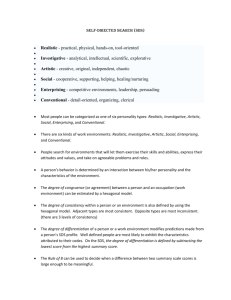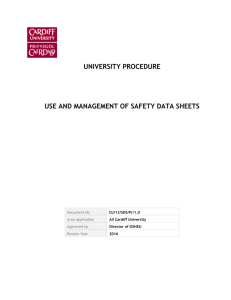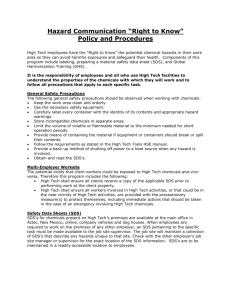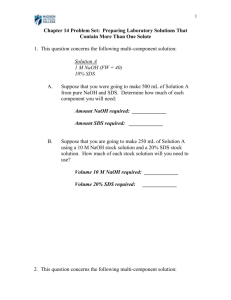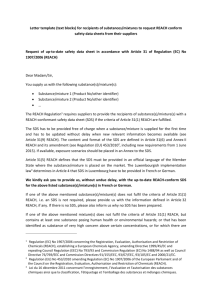Understanding Safety Data Sheets for Hazardous Chemicals
advertisement
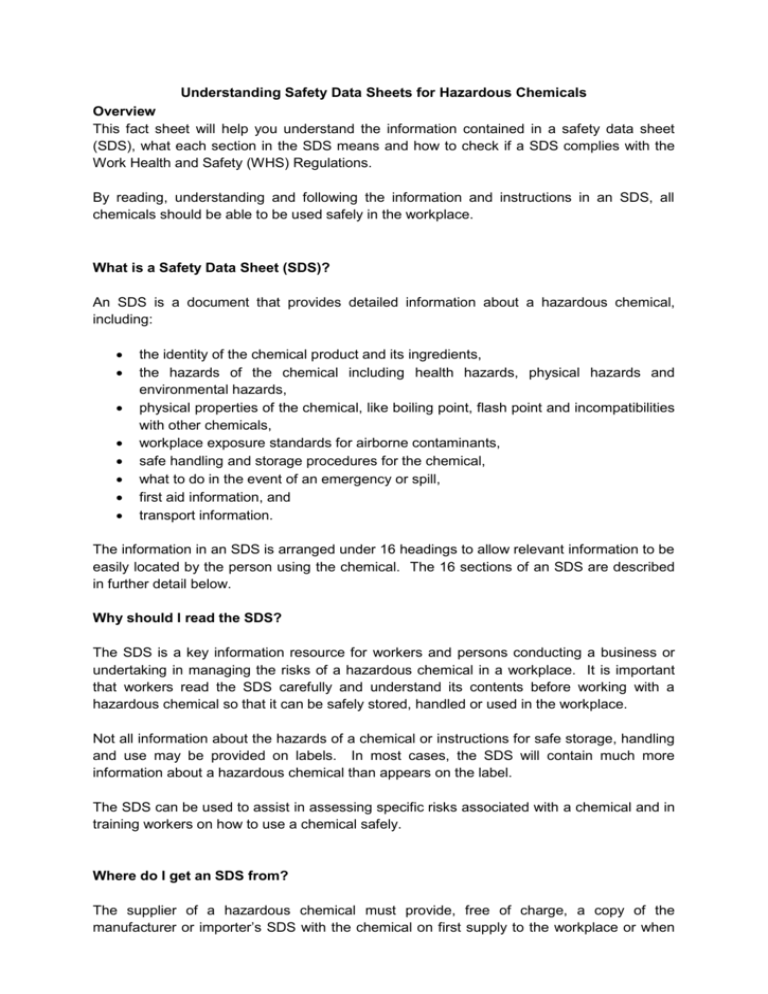
Understanding Safety Data Sheets for Hazardous Chemicals Overview This fact sheet will help you understand the information contained in a safety data sheet (SDS), what each section in the SDS means and how to check if a SDS complies with the Work Health and Safety (WHS) Regulations. By reading, understanding and following the information and instructions in an SDS, all chemicals should be able to be used safely in the workplace. What is a Safety Data Sheet (SDS)? An SDS is a document that provides detailed information about a hazardous chemical, including: the identity of the chemical product and its ingredients, the hazards of the chemical including health hazards, physical hazards and environmental hazards, physical properties of the chemical, like boiling point, flash point and incompatibilities with other chemicals, workplace exposure standards for airborne contaminants, safe handling and storage procedures for the chemical, what to do in the event of an emergency or spill, first aid information, and transport information. The information in an SDS is arranged under 16 headings to allow relevant information to be easily located by the person using the chemical. The 16 sections of an SDS are described in further detail below. Why should I read the SDS? The SDS is a key information resource for workers and persons conducting a business or undertaking in managing the risks of a hazardous chemical in a workplace. It is important that workers read the SDS carefully and understand its contents before working with a hazardous chemical so that it can be safely stored, handled or used in the workplace. Not all information about the hazards of a chemical or instructions for safe storage, handling and use may be provided on labels. In most cases, the SDS will contain much more information about a hazardous chemical than appears on the label. The SDS can be used to assist in assessing specific risks associated with a chemical and in training workers on how to use a chemical safely. Where do I get an SDS from? The supplier of a hazardous chemical must provide, free of charge, a copy of the manufacturer or importer’s SDS with the chemical on first supply to the workplace or when asked to do so. If the supplier has not provided you with an SDS for the chemical you are using, you should ask for it before working with that chemical. If the supplier will not provide you with an SDS after being asked for it, then contact your local work health and safety (WHS) regulator. Check if the SDS complies with the WHS Regulations You should always check that the SDS relates to the chemical that you have received or are using. This can easily be done by checking that the product or chemical name on the SDS is the same as on the product label of the container. Before using a chemical in the workplace, you should also make some simple checks to see whether it complies with the WHS Regulations. Is the SDS written in English? Does the SDS contain 16 separate headings? These, and the contents of each section, are further discussed below. Does the SDS state the name, address and business telephone number of the Australian importer or manufacturer? Does the SDS give an Australian business telephone number from which further information about the chemical can be obtained in an emergency? Was the SDS prepared within the last five years? If you cannot answer yes to all of the above questions, the SDS you have been given does not comply with the WHS Regulations. In this instance, you should contact the supplier, importer or manufacturer for an up-to-date and compliant SDS and refrain from using the chemical until you obtain the correct SDS. If the supplier cannot or will not provide a compliant SDS, contact your local work health and safety regulator. Keeping SDS in the workplace A register of hazardous chemicals used, handled or stored at the workplace must be prepared and kept up-to-date at the workplace and must also include the current SDS for each of these chemicals. This register must be readily available to all workers who use or may be affected by the chemicals at the workplace. What information is on an SDS? An SDS which complies with the WHS Regulations contains the following 16 separate sections each with specific information relating to the chemical being used, handled, stored, transported or disposed. Section 1 - Identification: Contains the product identifier or tradename, contact details of the manufacturer or importer responsible for supplying the chemical, and the telephone number to contact in case of an emergency. The information in this section should be consistent with the label. Section 2 – Hazard(s) identification Gives details on the potential health and physical hazards of the chemical. This information can be used to help assess the risks to the health and safety of workers, other people, and the environment. The information in this section should be consistent with the information on the label. In some cases there may be more information on the SDS than on the label. Section 3 - Composition and information on ingredients If the chemical is a mixture, this section should provide the information on the identity and proportions of hazardous ingredients in the mixture. Section 4 - First-aid measures Describes the necessary first aid measures to be taken in case of an accident. Section 5 - Fire-fighting measures Gives specific information on fighting a fire involving the chemical, including the most suitable extinguishing media and other protective measures. Section 6 - Accidental release measures Describes what actions need to be taken if there is an accidental release or spill of the chemical to minimise adverse effects on people, property and the environment. Section 7 - Handling and storage Contains details on how to handle and store the chemical safely to minimise the potential risks to people, property and the environment. Section 8 - Exposure controls and personal protection Provides information on control measures that can be used to reduce exposure, for example, engineering controls, information on exposure standards and guidance on required personal protective equipment (PPE). Section 9 - Physical and chemical properties Provides detailed information on the physical and chemical properties of the chemical, for example, appearance, odour, pH, flash point, melting/boiling point or any other relevant physical data. Section 10 - Stability and reactivity Contains details of any hazardous reactions that may occur if the chemical is used under certain conditions and details of any incompatible materials Section 11 - Toxicological information Provides detailed information on the toxicological properties of the chemical. This section is used primarily by medical professionals, toxicologists and WHS professionals. Section 12 - Ecological information Provides detailed information on the ecological hazard properties of the chemical. Section 13 - Disposal considerations Explains how the chemical should be disposed of correctly or recycled or reclaimed. Section 14 - Transport information Contains basic classification information like UN number and transport hazard classes and packing groups that relate to the transport of the chemical by road, rail, sea or air. Section 15 - Regulatory information Provides advice on other international or national regulatory information specific to the chemical, such as the Montreal protocol (ozone depleting substances), the Stockholm Convention(Persistent organic pollutants), Poisons scheduling or any other applicable Australian prohibition, notification or licensing requirements. Section 16 - Any other relevant information Provides any other information relevant to the preparation of the SDS, including the date of its preparation, a key or legend to abbreviations acronyms and references used. More information on safety data sheets, including the Code of Practice for the Preparation of Safety Data Sheets for Hazardous Chemicals with which manufacturers, importers and suppliers must comply, and other aspects of managing the risks associated with hazardous chemicals can be found on our website at www.safeworkaustralia.gov.au EXAMPLE SAFETY DATA SHEET


